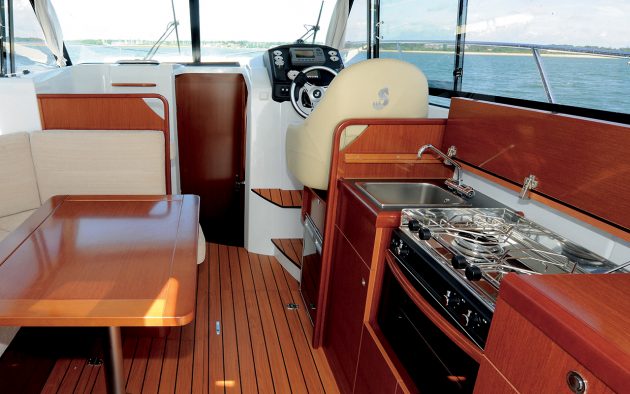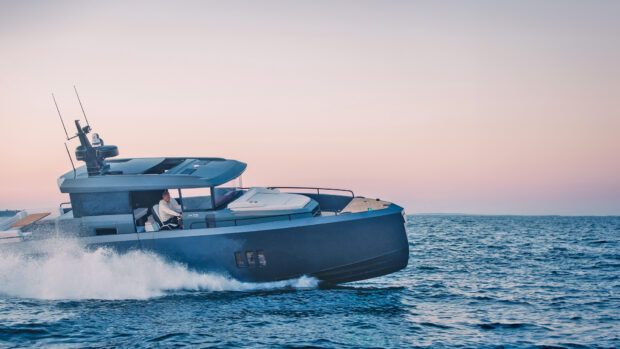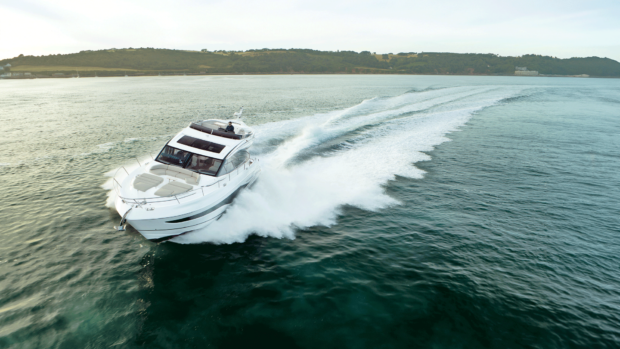An agile, nippy and self-assured ride, a superb interior, and a sweet spot of 20 knots: the Bénéteau Antarès 30 is a small flybridge with big benefits.
Very small flybridge boats tend to make me a little nervous. And 30-foot or so is about as small as flybridge boats get.
The thing is people don’t obligingly shrink on board small boats, so if a builder wants to maintain good headroom (as Bénéteau have done on the Antarès 30) there’s a limit to how far a designer can drive down the height and top hamper.
So, there’s always a risk of spawning a top-heavy boat that will wobble around excessively, making its passengers nervous and seasick. The easy answer is to bump up the beam.
Then the risk, especially with a small, light boat, is a craft that crashes and bangs its way around in anything other than a flat calm.
And despite its shallow draught (which unhelpfully decreases as the beam increases) a good small flybridge boat will also need to grip the water well, to compensate for what will inevitably be higher than average windage. Who would be a designer, eh?
Well, it seems Bénéteau would. Because I don’t think the Antarès 30’s hull could perform any more impressively.
All the way to its 26-knot top speed, it handled a choppy day in the Solent with aplomb, never once slamming even though we largely ignored the trim tabs.
Pushed above 12 knots or so, it firms up very positively and exhibits all the stability you could want.
Don’t let the typically low French flybridge bother you either – the ride and handling is so self-assured that it always feels safe and secure up top.

With its tiny 82 imp gal (375 litres) fuel tank refuelling will be a constant consideration.
At single-figure speeds, when its dynamic stability tails away, of course you temporarily feel the effect of big ferry washes, but never in an alarming way.
Thanks to its small keel and shaftdrive configuration, the Bénéteau Antarès 30 grips the water and tracks very well. At single-figure speeds, that grip naturally fades away, but as long as you don’t oversteer, the boat wanders very little.
However skilled you are at close-quarter manoeuvring, though, do take the optional bow thruster. Dancing around a busy Cowes marina in a Force 2 to 3, the Antarès 30’s high windage blew the boat around quite quickly.

Flybridge is only small, but it provides a great place for pilotage into strange harbours.
And with the only engine a single shaftdrive 380hp Yanmar (twins are not an option) I found the bow thruster essential for a collision-free escape. Small flybridge boats don’t tend to attract hooligans.
Still, if you feel like a spot of lunacy, you will be able to fling the Antarès around as crazily as is physically possible, and it will never misbehave.
Using Yanmar’s MFD (multi-function display) we recorded the fuel flow figures of the six-cylinder 5.8-litre diesel and surprisingly, the Antarès has a sweet spot at a usefully fast cruise of just under 20 knots, where it returned 2mpg.
Not until the speed drops below 9 knots does the efficiency improve again – crucial information if you’re slowing down to save fuel.

Helmsman’s seat-back hinges forward so all four crew can sit around the table.
And with its tiny 82 imp gal (375 litres) fuel tank providing enough range to get you from, say, the Solent to Dartmouth at 9 knots or above, but certainly not back again, refuelling will be a constant consideration.
As well as its assured handling, this boat has two other stand-out features. Small it may be, but all cruising boats need to absorb the usual cruising paraphernalia.
So whoopee for the amazingly generous and readily accessible lazarette and the trio of cockpit lockers – I’ve been on 60-footers with less cockpit stowage. Inside, the saloon windows will blow your mind.

Storage under saloon seats comprises neatly moulded lockers and a more accessible cave locker.
Not only are they ginormous, they also incorporate huge sliding sections on both sides – these improve communication with your crew no end, and if you can find a better ventilated 30-footer, it’s probably a RIB.
Headroom and berth sizes are all fine; forward cabin headroom aside everything else measures between 6ft 3in (1.91m) and 6ft 7in (2.01m), the sort of figures you expect for much bigger boats.
Storage in the main cabin is good, even excluding the bed, which lifts bodily to reveal a further four lockers and easy access to the bow thruster.

End of generous double hinges up to reveal four deep lockers and the bow thruster.
The only thing you might grumble about is the time it takes to access the engine through the saloon floor.
But that five-minute fiddle is the price you pay for the Antarès 30’s invaluable lazarette.
Bénéteau Antarès 30 verdict
It is amazing how much some builders can successfully pack into a small boat.
A place to eat and to cook, two cabins, a space for showering and other ablutions, a good flybridge, a roomy lazarette for all your cruising paraphernalia, and a big bathing platform.
Second heads aside, we could easily be describing a £400,000+ Princess 42! Of course, on the Princess, those aforementioned areas would be bigger.
But if you don’t fancy spending close to half a million pounds the Bénéteau Antarès 30 proves beyond doubt that it is perfectly possible for four people to go cruising on a flybridge boat, with fine handling, for £120,000.
On the Antarès 30, you probably won’t be trying as hard to impress the neighbours with your slick joinery and fancy leather upholstery.
But the sunsets won’t be any less spectacular, the Martinis no less mouthwatering, and your friends no less friendly.
What price a great cruising boat? Very little it would seem.
First published in the February 2011 issue of MBY.
Details
Price from: £114,814 (single 380hp)
Price as tested: £142,238 (single 380hp)
Length: 33ft 6in (10.22m)
Beam: 11ft 1in (3.39m)
Fuel capacity: 82 imp gal (375 litres)
Water capacity: 32 imp gal (145 litres)
Draught: 3ft 1in (0.95m)
Air draught: 11ft 10in (3.60m)
RCD category: B (for 8 people); C (for 10 people)
Displacement: 4.66 tonnes light (empty); 5.12 tonnes full fuel & water
Designers: Bénéteau
Contact: www.beneteau.com









